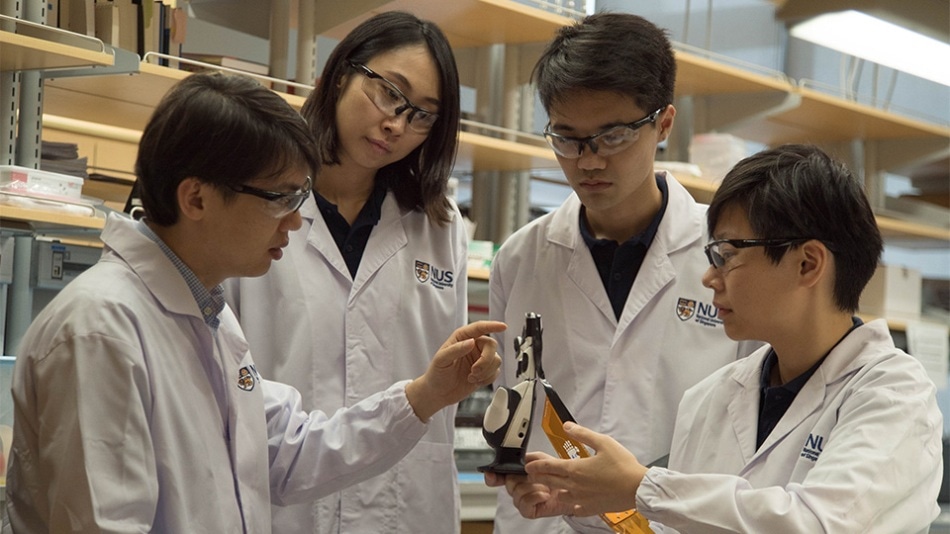Jul 19 2019
A research team from NUS has developed an artificial nervous system called the Asynchronous Coded Electronic Skin (ACES). With this system, prosthetic devices and robots could soon have a sense of touch comparable to, or even better than, the human skin.
 The ACES developed by Asst Prof Tee (far left) and his team responds 1000 times faster than the human sensory nervous system. (Image credit: National University of Singapore)
The ACES developed by Asst Prof Tee (far left) and his team responds 1000 times faster than the human sensory nervous system. (Image credit: National University of Singapore)
The new electronic skin system is sturdy against damage and has ultra-high responsiveness. It can be paired with any type of sensor skin layers to effectively function as an electronic skin.
The innovation, accomplished by Assistant Professor Benjamin Tee and his colleagues from the NUS Department of Materials Science and Engineering, was first described in Science Robotics, a prestigious scientific journal, on July 18th, 2019.
Faster than the Human Sensory Nervous System
Humans use our sense of touch to accomplish almost every daily task, such as picking up a cup of coffee or making a handshake. Without it, we will even lose our sense of balance when walking. Similarly, robots need to have a sense of touch in order to interact better with humans, but robots today still cannot feel objects very well.
Benjamin Tee, Assistant Professor, Department of Materials Science and Engineering, NUS
Asst Prof Tee has been working on electronic skin technologies for more than 10 years with the aim of giving prosthetic devices and robots a better sense of touch.
The NUS team drew inspiration from the human sensory nervous system and took a year and a half to develop a sensor system that could possibly perform better. Although the ACES electronic nervous system detects signals similar to the human sensory nervous system, in contrast to the nerve bundles in the human skin, it is formed of a network of sensors linked via a single electrical conductor. It is also contrary to prevalent electronic skins that have interlinked wiring systems that can render them difficult to scale up and sensitive to damage.
Asst Prof Tee, who also holds appointments in the NUS Electrical and Computer Engineering, NUS Institute for Health Innovation & Technology, N.1 Institute for Health, and the Hybrid Integrated Flexible Electronic Systems programme, further elaborated on the inspiration stating, “The human sensory nervous system is extremely efficient, and it works all the time to the extent that we often take it for granted. It is also very robust to damage. Our sense of touch, for example, does not get affected when we suffer a cut.”
He further added, “If we can mimic how our biological system works and make it even better, we can bring about tremendous advancements in the field of robotics where electronic skins are predominantly applied.”
When compared to the human sensory nervous system, ACES has the ability to detect touches 1,000 times more faster. For instance, it has the potential to differentiate physical contact between various sensors within 60 ns—the fastest ever realized for an electronic skin technology—even with more number of sensors.
Thanks to the high fidelity and capture speed of the ACES system, the ACES-enabled skin can also exactly identify the hardness, shape, and texture of objects within 10 ms, which is 10 times faster than the blinking of an eye.
It is also possible to design the ACES platform to realized high robustness to physical damage, a key property for electronic skins since they come into physical contact with the environment frequently.
In contrast to the existing system employed to interconnect sensors in current electronic skins, it is possible to connect all the sensors in ACES to a common electrical conductor, where each sensor operates independently. This enables the ACES-enabled electronic skins to continue operating as long as there is a connection between the conductor and the sensor, rendering them less susceptible to damage.
Smart Electronic Skins for Robots and Prosthetics
ACES includes a simple wiring system and exhibits exceptional responsiveness even if more number of sensors are incorporated. These significant features will pave way for the scale-up of intelligent electronic skins for Artificial Intelligence (AI) applications in prosthetic devices, robots, and other human-machine interfaces.
Scalability is a critical consideration as big pieces of high performing electronic skins are required to cover the relatively large surface areas of robots and prosthetic devices. ACES can be easily paired with any kind of sensor skin layers, for example, those designed to sense temperatures and humidity, to create high performance ACES-enabled electronic skin with an exceptional sense of touch that can be used for a wide range of purposes.
Benjamin Tee, Assistant Professor, Department of Materials Science and Engineering, NUS
As an example, when ACES was paired with the water-resistant, transparent, and self-healing sensor skin layer recently created by Asst Prof Tee’s team, the result is an electronic skin with the ability to self-repair, similar to the human skin. It would be possible to use this type of electronic skin to create more realistic prosthetic limbs that will assist disabled individuals to restore their sense of touch.
More intelligent robots with the ability to carry out disaster recovery tasks or perform mundane operations such as packing of items in warehouses are other prospective applications. Hence, the NUS researchers are aspiring to further use the ACES platform with prosthetic devices and advanced robots in the next phase of the study.
Novel artificial nervous system gives robots an exceptional sense of touch
(Video credit: National University of Singapore)